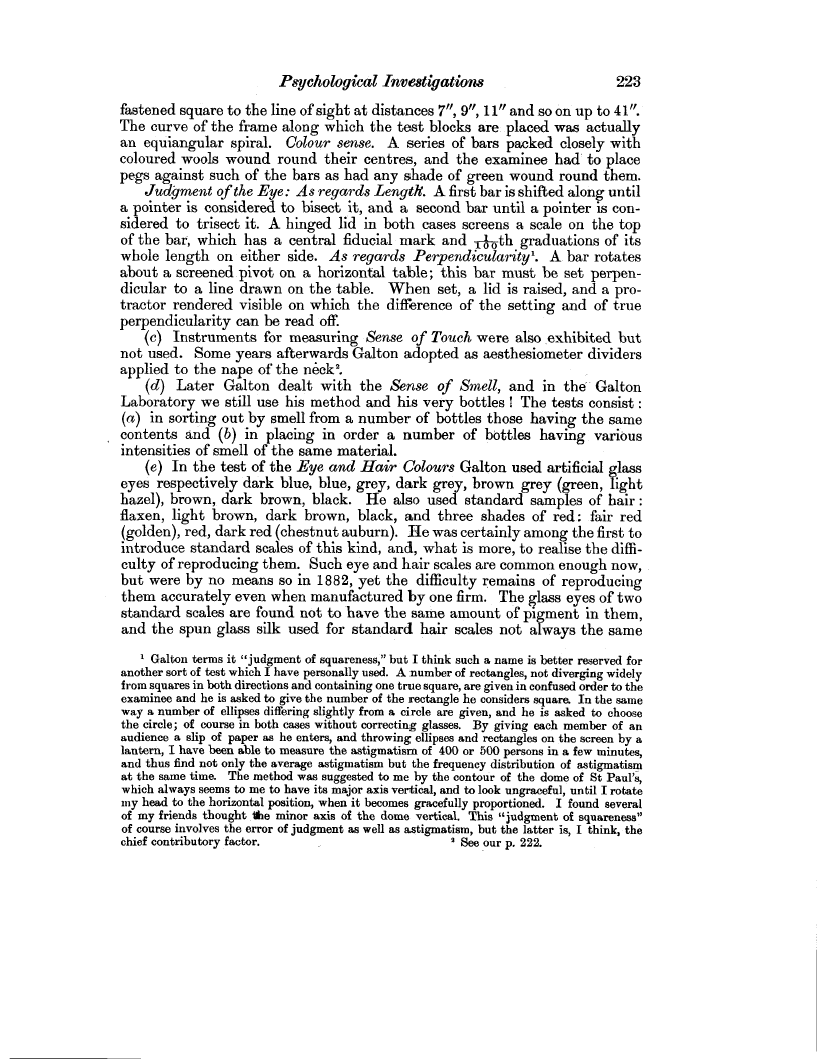Psychological Investigations 223
fastened square to the line of sight at distances 7", 9", 11" and soon up to 41". The curve of the frame along which the test blocks are placed was actually an equiangular spiral. Colour sense. A series of bars packed closely with coloured wools wound round their centres, and the examinee had to place pegs against such of the bars as had any shade of green wound round them.
Judgment of the Eye: As regards Length. A first bar is shifted along until a pointer is considered to bisect it, and a second bar until a pointer is considered to trisect it. A hinged lid in both cases screens a scale on the top of the bar, which has a central fiducial mark and 1-A th graduations of its whole length on either side. As regards Perpendicularity'. A bar rotates about a screened pivot on a horizontal table; this bar must be set perpendicular to a line drawn on the table. When set, a lid is raised, and a protractor rendered visible on which the difference of the setting and of true perpendicularity can be read off.
(c) Instruments for measuring Sense of Touch were also .exhibited but not used. Some years afterwards Galton adopted as aesthesiometer dividers applied to the nape of the neck'.
(d) Later Galton dealt with the Sense of Smell, and in the Galton Laboratory we still use his method and his very bottles ! The tests consist (a) in sorting out by smell from a number of bottles those having the same contents and (b) in placing in order a number of bottles having various intensities of smell of the same material.
(e) In the test of the Eye and Hair Colours Galton used artificial glass eyes respectively dark blue, blue, grey, dark grey, brown grey (green, light hazel), brown, dark brown, black. He also used standard samples of hair flaxen, light brown, dark brown, black, and three shades of red : fair red (golden), red, dark red (chestnut auburn). He was certainly among the first to introduce standard scales of this kind, and, what is more, to realise the difficulty of reproducing them. Such eye and hair scales are common enough now, but were by no means so in 1882, yet the difficulty remains of reproducing them accurately even when manufactured by one firm. The glass eyes of two standard scales are found not to have the same amount of pigment in them, and the spun glass silk used for standard hair scales not always the same
1 Galton terms it "judgment of squareness," but I think such a name is better reserved for another sort of test which I have personally used. A number of rectangles, not diverging widely from squares in both directions and containing one true square, are given in confused order to the examinee and he is asked to give the number of the rectangle he considers square. In the same way a number of ellipses differing slightly from a circle are given, and he is asked to choose the circle; of course in both cases without correcting glasses. By giving each member of an audience a slip of paper as he enters, and throwing ellipses and rectangles on the screen by a lantern, I have been able to measure the astigmatism of 400 or 500 persons in a few minutes, and thus find not only the average astigmatism but the frequency distribution of astigmatism at the same time. The method was suggested to me by the contour of the dome of St Paul's, which always seems to me to have its major axis vertical, and to look ungraceful, until I rotate my head to the horizontal position, when it becomes gracefully proportioned. I found several of my friends thought the minor axis of the dome vertical. This "judgment of squareness" of course involves the error of judgment as well as astigmatism, but the latter is, I think, the chief contributory factor. ' See our p. 222.

